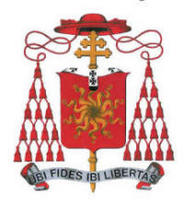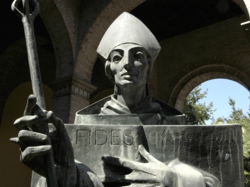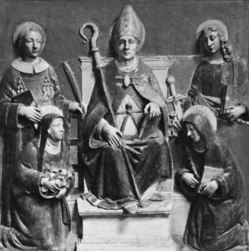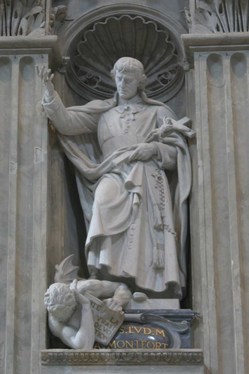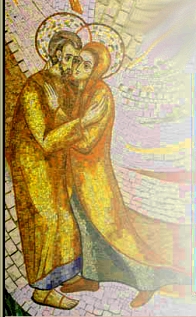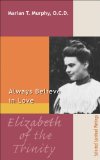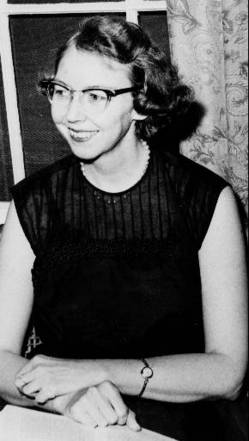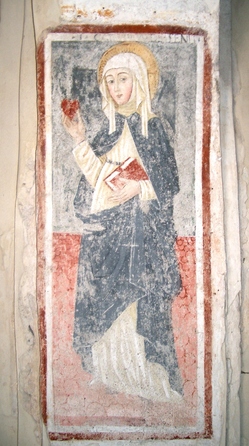 The Kingdom of heaven is like a merchant seeking good pearls, who, when he had found one of great price, gave all that he had and bought it, alleluia.
The Kingdom of heaven is like a merchant seeking good pearls, who, when he had found one of great price, gave all that he had and bought it, alleluia.
Newman answers prayers?
Here’s the Boston Globe’s story of a man’s healing through the intercession of John Henry Newman.
Saint Anselm sought to raise the mind to the contemplation of God, Pope reminds
Pope Benedict
XVI wrote to Cardinal Giacomo Biffi, retired archbishop of Bologna, on the
occasion of the ninth centenary of the death of Saint Anselm. I find this letter
to be an amazing testimony to the operative graces at work in the Church 900
years ago and today.
What is said by the Holy Father is a great reminder of what our aim ought to be
as faithful Christians, and for those called to ministry, what our
responsibilities are.
In view of the
celebrations in which you, venerable brother, will take part as my legate in
the illustrious city of Aosta in honor of the ninth centenary of the death of
St. Anselm, which took place in Canterbury on 21 April 1109, I would like to
give you a special message in which I wish recall the main features of this
great monk, theologian and pastor of souls, whose work has left a deep mark on
the history of the Church.
The anniversary
is indeed an opportunity not to be missed to renew the memory of one of the
brightest figures in the tradition of the Church and in the history of Western
European thought. The exemplary monastic experience of Anselm, his
original method of rethinking the Christian mystery, his subtle philosophical
and theological doctrine, his teaching on the inviolable value of conscience
and on freedom as the responsible adherence to truth and goodness, his
passionate work as a shepherd of souls, dedicated with all his strength to the
promotion of “freedom of the Church,” have never ceased to arouse in
the past the deepest interest, which the memory of his death is happily
reigniting and encouraging in many ways and in different places.
In this memorial
of the “Magnificent Doctor” — as St. Anselm is called — the Church
of Aosta cannot but be recognized, the Church in which he was born and which is
rightly pleased to consider Anselm as her most illustrious son. Even when he
left Aosta in the time of his youth, he continued to carry in his memory and in
his heart the bundle of memories that was never far from his thoughts in the
most important moments of life. Among those memories, a particular place was
certainly reserved for the sweet image of his mother and the majestic mountains of his
valley with their high peaks, and perennial snow, in which he saw represented,
as if in a fascinating and suggestive symbol, the sublimity of God. To
Anselm – “a child raised in the mountains,” as Admero his biographer
calls him, (Vita Sancti Anselmi,
i, 2) – God appears to be that of which you cannot think of something bigger
[the translator probably meant “greater”]: perhaps his intuition was not
unrelated to the childhood view of those inaccessible peaks. Already as a child
he thought that in order to find God it was necessary to “climb to the
summit of the mountain” (ibid.). In fact, he will realize more and more
that God remains at an inaccessible height, located beyond the horizons
which man is able to reach,
since God is beyond the thinkable. Because of this, the journey in search of
God, at least on this earth, will never end, but will always be thought and
desire, the rigorous process of the intellect and the imploring inquiry of the
heart.
The intense
desire to know and the innate propensity for clarity and logical rigor will
push Anselm towards the “scholeae” [schools] of his time. He will
therefore join the monastery of Le Bec, where his inclination for dialectic
reflection will be satisfied and above all, where his cloistered vocation will
enkindle. To dwell on the years of the monastic life of Anselm is to encounter
a faithful religious, “constantly occupied in God alone and in the
disciplines of heaven” — as his biographer writes — in order to achieve
“such a summit of divine speculation that would enable him by a path
opened by God to penetrate, and, once penetrated, to explain the most obscure
and previously unresolved questions concerning the divinity of God and our
faith and to prove with clear reasons that what he stated belonged to
sure Catholic doctrine” (Vita Sancti Anselmi, i, 7). With these words, his biographer
describes the theological method of St. Anselm, whose thought was ignited
and illuminated in prayer. It is he himself that confesses, in his famous
work, that the understanding of faith is an approach toward a vision, which we
all yearn for and which we all hope to enjoy at the end of our earthly pilgrimage,
“Quoniam inter fidem et speciem intellectum quem in hac vita capimus esse
medium intelligo: quanto aliquis ad illum proficit, tanto eum propinquare
speciei, ad quam omnes anhelamus, existimo (Cur Deus homo, Commendatio).
The saint
desired to achieve the vision of the logical relationships inherent to
the mystery, to perceive the “clarity of truth,” and thus to
grasp the evidence of the “necessary reasons,” intimately bound
to the mystery. A bold plan certainly, and it is one whose success still occupies
the reflections of the students of Anselm today. In fact, his search of the
“intellectus” [intellect] positioned between “fides”
[faith] and “species” [vision] comes out of the source of the same
faith and is sustained by confidence in reason, through which faith in a
certain way is illuminated. The intent of Anselm is clear: “to raise the mind to
contemplation of God”
(Proslogion,
Proemium). There remain, in any event, for every theological research, his
programmatic words: “I do not try, Lord, to penetrate your depth, because
I cannot, even from a distance, compare it with my intellect, but I want to
understand, at least up to a certain point, your truth, which my heart believes
and loves. I do not seek, in fact, to try to understand it in order to believe
it, but I believe in order to understand it.”[Non quaero intelligere ut
credam, sed credo ut intelligam] (Proslogion, 1).
In Anselm, prior
and abbot of Le Bec, we underline some characteristics that further define his
personal profile. What strikes us, first of all, is his charism as an expert
teacher of spiritual life,
one who knows and wisely illustrates the ways of monastic perfection. At the
same time, one is fascinated by his instructive geniality, which is expressed
in that discernment method
— which he names, the “via discretionis” (Ep. 61) — which is a
small image of his whole life, an image composed of both mercy and firmness.
The peculiar ability which he demonstrates in initiating disciples to the
experience of authentic prayer is very peculiar: in particular, his
“Orationes sive Meditationes,” eagerly requested and widely used,
which have contributed to making many people of his time “anime
oranti” [praying souls], as with his other works, have proved themselves a
valuable catalyst in making the Middle Ages a “thinking” and, we
might add, “conscientious” period. One would say that the most
authentic Anselm can be found at Le Bec, where he remained thirty three years,
and where he was much loved. Thanks to the maturity that he acquired in a
similar environment of reflection and prayer, he will be able, as well in the
midst of the subsequent trials as bishop, to declare: “I will not retain
in my heart any resentment for any one” (Ep. 321).
The nostalgia
of the monastery will
accompany him for the rest of his life. He confessed it himself when he was
constrained, to his deepest sorrow and that of his monks, to leave the
monastery to assume the Episcopal ministry to which did not feel well disposed:
“It is well known to many,” he wrote to Pope Urban II, “the
violence which was done to me, and how much I was reluctant and contrary, when
I was brought as a bishop to England and how I explained the reasons of nature,
age, weakness and ignorance, which were opposed to this office and that absolutely
detest and shun scholastic duties, which I cannot dedicate myself to at all
without endangering the salvation of my soul” (Ep. 206). He confides later
with his monks in these terms: “I have lived for 33 years a monk —
three years without responsibility, 15 as prior, and as many as abbot — in
such a way that all the good people that knew me loved me, certainly not by my
own merits but for the grace of God, and the ones that loved me most
were those that knew me most intimately and with greatest familiarity” (Ep. 156). And he added: “You
have been many to come to Le Bec … Many of you I surrounded with a love
so tender and sweet
that each one had the impression that I did not love anyone else in the same
way” (ibid.).
Appointed
Archbishop of Canterbury and beginning, in this way, his most troubled journey,
his “love of truth” (Ep. 327), his uprightness, his strict loyalty to
conscience, his “Episcopal freedom” (Ep. 206), his ” Episcopal
honesty” (Ep. 314), his tireless work for the liberation of the Church
from the temporal conditionings and from the servitude of calculations that are
incompatible with his spiritual nature will appear in their full light. His
words to King Henry remain exemplary in this respect, “I reply that in
neither baptism nor in any other ordination that I have received, did I
promised to observe the law or the custom of your father or of the Archbishop
Lanfranco, but the law of God and of all the orders received” (Ep. 319).
For Anselm, the primate of the Church of England, one principle
applies: “I
am a Christian, I am a monk, I am a Bishop: I desire to be faithful to all,
according to the debt I have with each”
(Ep. 314). In this vein he does not hesitate to say: “I prefer to be in
disagreement with men than, agreeing with them, to be in disagreement with God” (Ep. 314). Precisely for this
reason he feels ready even for the supreme sacrifice: “I am not afraid to
shed my blood, I fear no wound in my body nor the loss of any material
good” (Ep. 311).
It is
understandable that, for all these reasons, Anselm still retains a great
actuality and a strong appeal, in as much as it is fruitful to revisit and
republish his writings, and together meditate continuously on his life. For
this reason I have rejoiced that Aosta, on the occasion of the ninth centenary
of the death of the saint, has distinguished itself with a set of appropriate
and intelligent initiatives — especially with the careful edition of his works
— with the intention to make known and loved the teachings and examples of this,
its illustrious son. I entrust to you, Venerable Brother, the task of bringing
to the faithful of the ancient and beloved city of Aosta the exhortation to
remember with admiration and affection this great fellow citizen of theirs,
whose light continues to shine throughout the Church, especially where the love
for the truths of faith and the desire for their study by the light of reason
are cultivated. And, in fact, faith and reason — “fides et ratio” — are united admirably in
Anselm. I send, with these heartfelt sentiments through you, venerable
brother, to the Bishop, Monsignor Giuseppe Anfossi, the clergy, the religious
and the faithful of Aosta and to all those who take part in the celebrations in
honor of the “Magnificent Doctor,” a special apostolic blessing,
propitiatory of an abundant outpouring of heavenly favors.
Father Theodore Heck, OSB: RIP
 Remember not the sins of my youth and all my follies, O Lord.
Remember not the sins of my youth and all my follies, O Lord.
Saint Louis-Marie Grignion de Montfort
O God, who willed to guide the steps of your priest, saint
Louis-Marie, into the way of salvation and of delight in Christ in the company
of the Blessed Virgin, grant that we, by following his example, may meditate
the mysteries of your love and devote ourselves tirelessly to the upbuilding of
your Church.
Saint Louis-Marie’s Total Consecration to the Blessed Virgin
Mary can
be followed here.
And if you want to know more about the rosary, read a classic: The Secret
of the Rosary by Saint Louis-Marie Grignion de Montfort.
A brief biography of Saint Louis-Marie can be read here.
All of Montfort’s works are worthy of time but especially noteworthy is the Total Consecration.
The Beauty and The Spirituality of Conjugal Love, the republished texts on married love by Karol Wojtyla/John Paul II
Recently a group
of priests re-published a set of texts written by Karol Wojtyla/John Paul II
about marriage and family. The book is called The Beauty and The
Spirituality of Conjugal Love.
Karol Wojtyla
wrote these texts in 1962 while he was the cardinal archbishop of Krakow based on
his pastoral experience in the years following the Second World War with young
and married peoples.
The point of
Wojtyla’s writing is to promote communion among people, especially married peoples, so as to live the Christian life. This book is a method of living married life in faith and not as a set of rules and prohibitions. These texts were published again in published 1990s but
received little attention. They are now offered again as a guide to marriage in the 21st century.
The video clip on the presentation.
Elizabeth of the Trinity: Always Believe in Love
We are made for others. The human heart naturally reaches out, even craves and depends on friendship. The truest desire of communion of heart, mind and body happens in the with God (or at least it ought to begin with God) and then there ought to be a communion with another human being as is found in marriage, friendship or religious life. From experience, we understand that man and woman are incomplete without some fulfilling relationship but the fulfillment comes not from any relationship; it comes from a place deep in the human experience, the correspondence of the heart. Christians exist in a companionship that has divine and human coordinates. Analogically, we say the same of God. Catholics are not Unitarians (though you would not know by the way they act and speak about God sometimes); Catholics believe in and relate to God who is a trinity of persons: Father, Son, and Holy Spirit. We pray to God the Father through Jesus Christ under the power of the Holy Spirit. Further, Catholics say that the Trinity decided, because of their love, that the second person of the Trinity, would become man and open the gates of heaven so that humanity might know, love and serve God.
When it comes to the concrete, our faith in Christ as the Word made flesh indicates to us that we engage in reality precisely because the Lord entered into human history. But there are obstacles for a solid engagement of culture in an era that holds fast to a variety conflicting epistemologies that are contrary to the Gospel and orthodox theological reflection. Moreover, it may be difficult for some people to believe in and experience the reality of love: do we know that we fight to love and to receive love? Do we really accept that humanity is impoverished when love is absent or dysfunctional? Then there is the issue of believing that the intentions of a lover toward his (her) beloved are pure and oriented toward the good. Sadly, the idea that we ought to have affection for ourselves is often perceived as new news and met with no small amount of skepticism. One way of engaging life is having affection for ourselves -NOT egotism– but a genuine affinity for the self which opens the door to see life differently. Affinity for self and others can be another way of speaking about love, but the use of the word “affinity” gives us a new set of eyes and legs for engaging reality that is before us. Having affection for oneself means that we lean toward our destiny more seriously, intentionally and with wholesomeness so as to live a companionship desired for us by God.
A recently published book puts our view of reality, love and God on end. Elizabeth of the Trinity: Always Believe in Love, edited by Marian T. Murphy, OCD (New City Press, 2009) is a wonderful collection of writings of this relatively unknown saint-to-be, Blessed Elizabeth of the Trinity. Elizabeth was a Carmelite nun who spent five years in a Carmelite monastery before dying at the age of 26. She is revered as a mystic with a profound understanding of the doctrine of the Blessed Trinity, and that’s not only because her religious name in the convent acknowledges a fact after a spiritual experience. The book includes extracts from Elizabeth’s diary, letters, poems, retreat notes, a prayer, a chronology and a select bibliography among other things. This volume is my first introduction to the person and thought of Blessed Elizabeth save for Father Henry dropping her name in a homily or two. The holy and human attractiveness of Blessed Elizabeth confirms my suspicion that we want, need men and women to point the way to a deeper union with God: with Elizabeth (and countless others) there is no reason why Catholics have to search for mystical experiences in other faith traditions. What I came to realize is how profoundly centered on the love of the Trinity this young woman was, and how her mission to lead others directly to Christ was keen. What the Second Vatican Council asked us to do, that is, to reclaim to claim a personal holiness centered on the Incarnation, Elizabeth promoted in the 19th century by telling us: “Look at every suffering and every joy as coming directly from Him, and then your life will be a continual communion, since everything will be like a sacrament that will give you God.” There’s no separation from between life and God. Do we live our lives with this conviction? Can we see this belief in our daily actions? One learns among many things in this volume that Pope John Paul II was influenced by Blessed Elizabeth and so made it his mission to make her known to the Church. At the foot of Elizabeth we realize ever more deeply that in being loved we can love.
As the editor Sister Marian said so very well in her excellent introduction: “The saints are God’s glorious palette, and without them, as Chesterton said: ‘we could lose the humanity of Christ’; for in them, we experience his rootedness in our ordinary lives. Their passionate, single-minded following of Christ fascinates us as we recognize the source of their, and our, true greatness.”
God’s greatness is experienced in humble ways
When the Lord of the world comes and undertakes the slave’s task of foot-washing – which is an illustration of the way he washes our feet all through our lives – we have a totally different picture. God doesn’t want to trample on us but kneels down before us so as to exalt us. The mystery of the greatness of God is seen precisely in the fact that he can be small… Only when power is changed from the inside, and we accept Jesus and his way of life, whose whole self is there in the action of foot-washing, only then can the world be healed and the people be able to live at peace with one another. Pope Benedict XVI
Reflecting on recent events in Catholic Higher Education: the Obama/Glendon craziness
Tonight’s TV
news on NBC drew the world’s attention to the fact that Mary Ann Glendon
declined Notre Dame’s famous Laetare Medal that is given at the commencement
exercises in May. By the way, 2009 marks the 126th year of the award. The medal
honors the distinguished work of Catholics; once reserved for the laity now
also given to the clergy and religious. These events have me thinking about the
meaning of these events surrounding the craziness of inviting the US president
who stands contrary to Catholic faith and Professor Glendon who is a faithful
Catholic to be on the same stage.
It seems to me
that when you pan the comments of academics at Catholic colleges and university
what you don’t see is rhetoric about Christ, faith as a way of knowing, truth,
the objectivity of the Church, the intersection of faith and reason, etc. What you will find are comments like:
“We don’t see a conflict with our Catholic identity if we have a speaker on
campus who may have views that are in conflict with Catholic teachings. We
consider the contributions the speaker has made to society as a whole, and that
doesn’t necessarily mean we endorse all of their positions or views. We’re
committed to a Jesuit tradition, which doesn’t suppress educational issues and
intellectual debate,” said Kristine Maloney, a spokeswoman for the College of
the Holy Cross in Worcester, MA. But Ms. Maloney fails to understand that this
type of forum gives credence of equality to contrary views to Catholic faith.
Obama’s speech is a monologue not a dialogue.
Or, let’s take
the president of Trinity Washington University’s Patricia McGuire who reminds
us that Catholics have long struggled to get a place of respectability in the
market place of ideas and that to blindly follow the bishops would simply be
parochial. In her estimation, “The
diminishment of the idea of the university by [some critics] betrays two
centuries of intellectual advancement and real leadership by Catholic higher
education in this nation.” Really, I don’t think it is narrow-minded to stand
with the Church I profess to believe in and follow unto my salvation in Christ.
Let’s just take
the Jesuit college’s perspective since there are far more people memorized by
the so-called Jesuit tradition realizing neither the history nor the aim of
Jesuit, Catholic education. Let’s remember what many faculty members said at
the last search for a Holy Cross College president: we don’t want a lay person
as president because he or she might make the College too Catholic; a Jesuit is
freer to allow us to think and act the way we want. Hence, what you see
embedded in Ms. Maloney’s remarks about the Jesuit intellectual life of the
university is true now but historically that same Jesuit intellectual tradition
followed Christ unconditionally because it was rooted in the Spiritual
Exercises. In fact, contemporary Jesuit apostolates are said to exist “To
follow Christ bearing his Cross means announcing his Gospel of hope….” Jesuit
institutions stood for faithfulness to the Gospel, to Church teaching and the
dignity of the human person. The Jesuit educational apostolate explored the
limits of faith and reason but always came back to faith as the mother of
virtue and true knowledge. In a former time there was not a capitulation to
secular values that divorces Christ from reality, that removes the Church from
the public square or merely wants to fit-in at all costs.
I fail to see
why fitting-in is a value for academics at Catholic institutions: theirs is a quest for the reasonableness of Truth. Being like
the professors in secular universities in my estimation is a failed enterprise
and one that has lead away from Jesus Christ as Savior and reality. True to the
Ignatian heritage of Jesuit educational institutions it would be good if Holy
Cross College and 27 other Jesuit colleges and universities did the Examen according
to the mind Saint Ignatius of Loyola asking the Lord for the grace of
conversion while attempting to live in “that harmony with the Magisterium which
avoids causing confusion and dismay among the People of God” (Benedict XVI to
the Jesuits, 2008)
Many US
Catholics seem comfortable with beige Catholicism and a theology based on
sentiment. There is no arguing otherwise given Notre Dame’s honoring of
President Obama and now the growing list of “Catholic” institutions of higher
learning caving to political pressure and respectability with no significant
outcry from the bulk of 60 million Catholics in the US. When encountering Saint
Peter at the heavenly gates I hope the academics don’t get offended if Saint
Peter has a different view on what it means to be a Catholic and to labor at a
Catholic higher educational institution. Let’s be clear: Christ didn’t come to
found a Catholic university–He came to bring us to the Father with the distinct
claim that He, Christ, is the way, the truth, and the life. Anything short of
that is nonsense.
In world where
clarity of Catholic faith is “normal” Catholic education would not afraid of
differing theological or philosophical positions, especially those that may run
contrary to orthodox Catholic teachings; in fact, a Catholic ought to be
respectful of what others have to say, always proposing the Gospel and the
Church teaching as true and a place of encounter with Christ. Having said this, a platform at a
Catholic institution needs to sensitively, yet firmly follow Christ and the
teachings of His Church. Clearly, playing footsy with positions contrary to the
Church cannot not be presented as equally valid to what the Church holds or
teaches!
Let’s not grow faint of heart by following Christ and keeping in mind the motto of the Laetare Medal: Magna est veritas et prevalebit (Truth is mighty, and it will prevail).
Reason, Fiction and Faith: a conference on Flannery O’Connor
An International Flannery O’Connor Conference
The April 20-22,
2009 conference was sponsored by the Poetics & Christianity
which is “an international forum for studying the intersection of artistic
culture and expressions of religious faith, with a special emphasis on
narrative and dramatic arts. It offers a meeting place for scholars and artists
of diverse fields of expertise.”
The O’Connor Conference was the 4th gathering
of scholars and other interested parties matters pertaining to art and faith.
Since Flannery O’Connor is relatively unknown in Europe, Father Wauck felt it was time
to introduce the world to writer who lived her Catholic faith and wrote fiction
using Catholic sacramentality. Father Wauck said,
“Flannery O’Connor’s fiction offers an example of what
Catholic art can achieve when it’s fully informed by a sophisticated
theological understanding, a rigorous philosophical background, and also the
kind of dedication to craft, to the artistry of writing that she combined.”
A video clip on the conference can be seen here.
